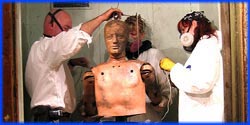


Premier Date: February 13, 2016
In this episode, Adam and Jamie revisited past myths due to comments and complaints from fans.
busted
Originally, Adam and Jamie tested this myth on an asphalt surface. This time, they laid out a 2-mile (3.2 km) course on dirt and each of them drove two laps. Jamie drove conventionally (no drifting) and recorded times of 2:24 and 2:22, while Adam drifted at every opportunity and recorded times of 2:24 and 2:23. After viewing the camera footage they noticed that Adam fell behind Jamie on gentle turns due to a loss of traction, while Jamie fell behind on sharp turns due to a larger loss of momentum. The inconclusive results led them to judge the myth busted.
plausible
Adam and Jamie set up a dummy torso made of ballistic gelatin and placed a lighter where a breast pocket would be. They started by firing a .22 rifle directly at it using full metal jacket rounds with a muzzle velocity of 1,440 feet per second (440 m/s). The bullet easily punched through the lighter and penetrated nearly to the back of the dummy.
Theorizing that a ricochet might affect the results, they set up a concrete paving stone to bounce the bullet into the lighter. They calibrated their shot using a cardboard target and a few trial shots with the paver at different angles (45, 25, and 15 degrees). With the dummy back in position, a 15-degree ricochet shot bounced off the concrete and hit the lighter perfectly. The bullet only dented the lighter, prompting them to classify the myth as plausible.
confirmed
Adam and Jamie set up a glass-walled fish tank with a dummy torso behind it. They fired a 12-gauge shotgun at it using three different types of ammunition: birdshot, buckshot, and a deer slug. The dummy remained completely undamaged after all three tests. In the birdshot test, the pellets broke through the front wall of the tank and lost so much energy upon entering the water they did not reach the back wall. The buckshot results were similar, with the back wall remaining unbroken. Although the deer slug passed through both walls, it became deformed and lost most of its velocity, falling away from the dummy as it emerged.
busted
Adam and Jamie chose to set up the explosions on the surface of a quarry lake in order to be able to clearly see the shock waves on the surface of the water. Adam built an 8-foot (2.4 m) long platform and fitted it with seven pressure sensors at 1-foot (0.30 m) intervals. They placed the sensor platform and a 5-pound (2.3 kg) charge of TNT on the lake. The charge was placed 5 feet (1.5 m) from one end of the platform and 3 feet (0.91 m) above the water surface. When they set off the charge, they recorded readings decreasing from 135 pounds per square inch (930 kPa) to 25 pounds per square inch (170 kPa), with 50 pounds per square inch (340 kPa) at the midpoint of the platform. A second test, with two TNT charges set 5 feet (1.5 m) from opposite ends and detonated at precisely the same time, produced a reading of 100 pounds per square inch (690 kPa) at the midpoint of the platform. This definitively busted the myth and Jamie noted that the pressure waves from the two explosions added to each other instead of canceling out.
Previous: Episode 242: Volunteer Special
Next: Episode 244: Rocketman